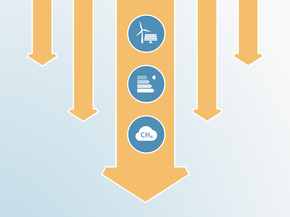Pledges And Targets
Summary table

Paris Agreement
Brazil ratified the Paris Agreement on September 21, 2016, committing to reduce emissions to 1.3 GtCO2e by 2025 and 1.2 GtCO2e by 2030 (Government of Brazil, 2015), as stated originally in its INDC (Intended Nationally Determined Contribution), which is equivalent to 37% and 43% below 2005 emissions levels including LULUCF (GWP-100; IPCC AR5)1.
While the nominal reduction targets appear to be challenging and ambitious at first glance, after taking into account that the base year for the NDC targets (2005) was a year with particularly high emissions, the real target represents very little effort beyond current ambition levels. Between 2005 and 2012, LULUCF emissions decreased 86% in Brazil thanks to the successful implementation of anti- deforestation policies, resulting in a decrease of 55% in total net emissions in the same period. This means that the NDC effectively translate to a decrease of only 7% in emissions incl. LULUCF below 2012 levels by 2030.
The CAT assesses emissions excluding LULUCF, and shows emissions from LULUCF separately. We rate governments only based on emissions excluding the LULUCF sector. Taking into account the strong decrease observed in LULUCF emissions between 2005 and 2012 and the projected emissions levels for this (Ministério da Ciência Tecnologia Inovações e Comunicações Brasil, 2017), the CAT estimates that the NDC targets translate to an increase in non-LULUCF emissions above 2005 levels (GWP-100; IPCC SAR) of 15% in 2025 and 3% in 2030 (equivalent to 73% and 55% above 1990 levels [GWP-100; IPCC SAR]).
These values are lower than in our previous assessments due to changes in LULUCF projections: In previous versions of our assessment we used LULUCF emissions projections consistent with the REDD PAC model, as used originally by the Brazilian Government for the formulation of the NDC (REDD and Policy Assessment Centre, 2015). However, due to methodological differences and modelling assumptions, the Brazilian Government has abandoned the REDD PAC model in its discussion on how to implement the NDC.. For this year´s assessment we have updated our LULUCF emissions projections to reflect the Brazilian Government’s most recent modelling exercise (Ministério da Ciência Tecnologia Inovações e Comunicações Brasil, 2017), which has higher emissions projections from this sector than in the REDD PAC model.
1 | On April 2016, the Brazilian government submitted a new GHG Inventory with revised historical data up to 2010 (Ministry of Science Technology and Innovation of Brazil, 2016b), which includes significant changes in historic data for the LULUCF sector compared with the last available data of the Second Biennial Report of Brazil to the UNFCCC (Ministry of Science and Technology of Brazil, 2014). For more details about the implications of the updated historic data for the emissions targets see Box 1 in CAT 2016 Brazil assessment.
Copenhagen Pledge for 2020
Brazil was one of the first major developing countries to put forward an emissions reduction target with its Copenhagen pledge in January 2010. It committed to reducing its emissions incl. LULUCF by between 36.1% and 38.9% in 2020, compared to BAU emissions. This target is equivalent to a 117–134% increase on 1990 levels excl. LULUCF. The target was turned into national law in December 2010, which contained no conditionality on international funding, making it more stringent than Brazil’s international target (Presidência da República, 2010).
However, there was also a difference in the proposed BAU: it increased. Whereas Brazil’s Copenhagen Pledge suggested a BAU level of 2.7 GtCO2e/a by 2020, its national law includes a BAU level of 3.2 GtCO2e/a with the same percentage reduction. That translated into a 20% increase of 2020 emissions levels compared to the Copenhagen Pledge.
To achieve its pledge, Brazil has proposed a series of measures and policies targeting the LULUCF sector and, notably, the government has committed to reducing annual deforestation rates by 80% below average levels 1996–2005 by 2020. By 2012, Brazil had already achieved most of those reductions, leading to an abrupt and significant decrease in LULUCF emissions of about 86% from 2005–2012.
Further analysis
Latest publications
Stay informed
Subscribe to our newsletter




